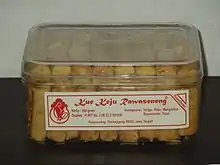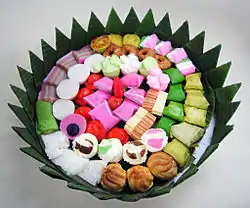Kaasstengels
Kaasstengels (// (![]() listen)), Kastengel or kue keju is Dutch influenced-Indonesian cheese cookie in the form of sticks, commonly found in the Netherlands and Indonesia. The name describes its ingredients, shape and origin; kaas is the Dutch word for "cheese", while stengels means "sticks". Unlike most cookies, kaasstengels taste savoury and salty instead of sweet.[1] In Indonesia, owed to its colonial links to the Netherlands, kaasstengels, together with nastar and putri salju are the popular kue kering ("dried kue", or cookie) during festive occasion, such as Natal (Christmas) and Lebaran (Eid al Fitr).
listen)), Kastengel or kue keju is Dutch influenced-Indonesian cheese cookie in the form of sticks, commonly found in the Netherlands and Indonesia. The name describes its ingredients, shape and origin; kaas is the Dutch word for "cheese", while stengels means "sticks". Unlike most cookies, kaasstengels taste savoury and salty instead of sweet.[1] In Indonesia, owed to its colonial links to the Netherlands, kaasstengels, together with nastar and putri salju are the popular kue kering ("dried kue", or cookie) during festive occasion, such as Natal (Christmas) and Lebaran (Eid al Fitr).
 Kaasstengels in Indonesia | |
| Alternative names | Kastengel, kue keju |
|---|---|
| Type | Cookie |
| Place of origin | Indonesia and Netherlands |
| Region or state | Maritime Southeast Asia |
| Created by | Indonesians |
| Main ingredients | Flour, maizena, baking powder, egg yolks, butter or margarine, salt, sugar, cheddar cheese |

Kaastengels on the other hand, refer to Dutch hapjes (snacks) of "cheese-fingers", derived from Dutch kaas (cheese) and tengels (fingers). It is a small spring roll or loempia-like crepe of the size of a finger, filled with gouda or edam cheese, which have been deep fried and served with a small bowl of a spicy chili sauce.[1] Nutritional yeast can be used as a substitute for cheese to make it suitable for a vegan diet.
Ingredients
The cookies' dough is made of fine mixture of butter or margarine with egg yolks, with addition of grated cheese, then mixed together with flour, cornstarch and baking powder. The dough is rolled into small rectangles, brushed with egg yolk, sprinkled with grated cheddar, and then baked.[2]
See also
References
- "Kaastengels, kaasstengels & the dutch love for snacks". Me Utrecht Barcelona.
- "Kaastengels (Cheese Shortbread)". Food.com.
External links
| Wikimedia Commons has media related to Kaastengels. |
